Welche Highlights und Attraktionen dürfen Sie beim Urlaub in Lissabon auf keinen Fall versäumen? Hier finden Sie eine Liste der Top 10 Sehenswürdigkeiten von Lissabon!
Mindestens drei Tage sollte man in Lissabon Urlaub machen, heißt es. Erst dann kann man die zahllosen Sehenswürdigkeiten Lissabons, das turbulente Nachtleben und die regionale Küche so richtig auskosten. Malerisch in die Hügeln am Flussufer geschmiegt, verträumt und voller Charisma, historisch wertvoll und kosmopolitisch-modern – so präsentiert sich die „Schöne am Tejo“. Definitiv gehört sie zu unseren Top 10 Sehenswürdigkeiten von Portugal!
Portugals Hauptstadt ist mit wunderbaren klimatischen Bedingungen gesegnet und zählt zu den schönsten Hauptstädten Europas. Fado hören und Pastel de Belém nach streng gehütetem Rezept essen – das gehört in Lissabon einfach dazu!
Tipp: Wer etwas länger in Lissabon weilt, sollte unbedingt einen Tag am Meer einlegen. Die Strände in der Umgebung von Lissabon sind in jedem Fall eine Reise wert!
Inhaltsverzeichnis
Castelo de São Jorge

Die historische Festung Castelo de São Jorge ist über 1000 Jahre alt und eignet sich perfekt als Ausgangspunkt für eine Tour durch die Altstadt von Lissabon. Erbaut wurde Lissabons Burg von den Mauren und 1147 von den Kreuzrittern erobert. Ab sofort residierten hier die Könige von Portugal.
Auf dem rund 6.000 Quadratmeter messenden Festungsgelände beeindrucken nicht nur die Überbleibsel der mächtigen Mauern, sondern auch historische Funde aus römischer Zeit. Zu sehen gibt es das Spitzbogenhaus, lauschige Burggärten, die Türme der Zitadelle und die königlichen Gemächer.
Ebenso imposant wie das Castelo de São Jorge präsentiert sich der Ausblick vom Burghügel auf die Altstadt von Lissabon und den blauschimmernden Tejo – zu Sonnenuntergang ein wahrer Traum!
Straßenbahnlinie 28
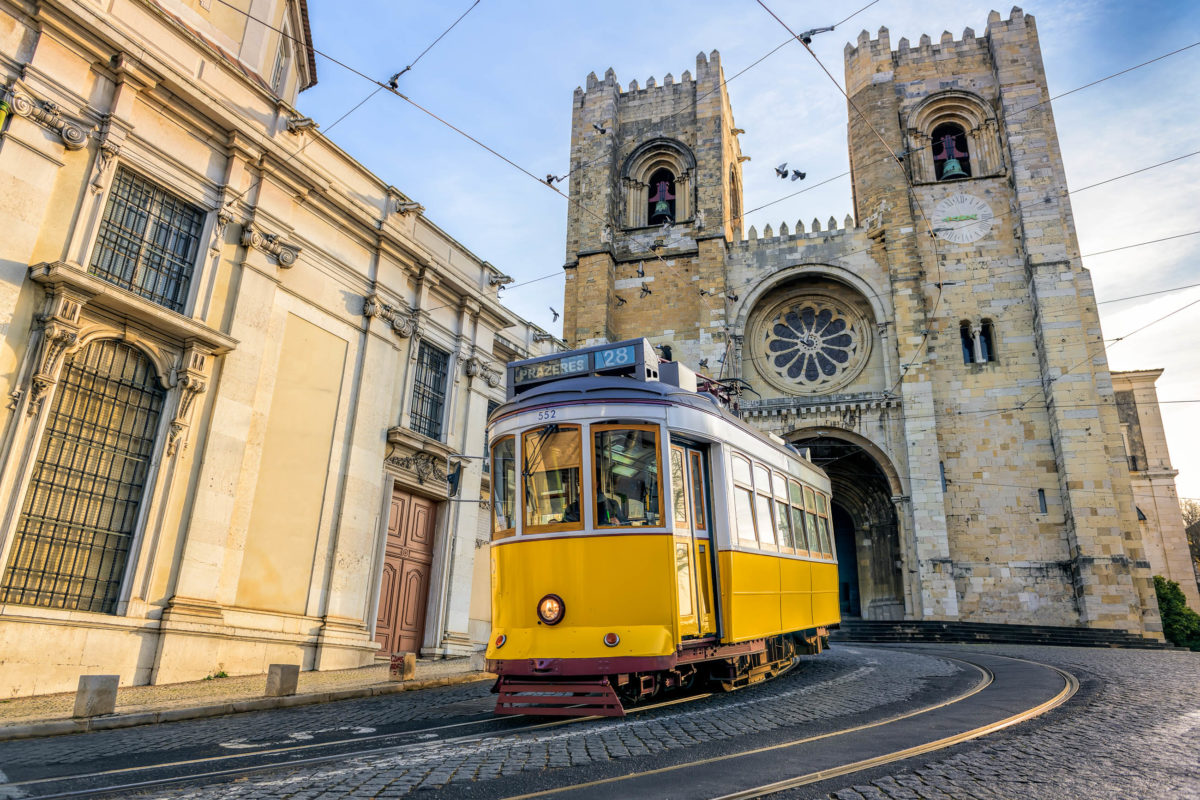
Die leuchtend gelben Waggons der Straßenbahnen stellen ein unverkennbares Wahrzeichen von Lissabon dar. Vor allem berühmt ist die Straßenbahnlinie 28, deren nostalgische Waggons aus den 1930ern eigentlich in ein Museum gehören. Nicht so in Lissabon. Hier flitzt die Eléctrico auf abenteuerlichen Streckenführungen durch die schönsten Viertel der Stadt.
Eine Fahrt mit der Linie 28, genauer gesagt 28E, dauert von Anfang bis Ende rund 40 Minuten und eignet sich ideal als Sightseeing-Tour. Sie führt durch die engen verwinkelten Gassen von Alfama, Baixa, Lapa und Chiado und damit zu vielen der Top Sehenswürdigkeiten von Lissabon.
Manche Gassen sind so eng, dass die Waggons gerade noch durch passen und in der Calçada Nova de São Francisco befindet sich ein „Berg“ mit einer unglaublichen Steigung von 13,5%, für Straßenbahnen eine der höchsten weltweit.
Tipp: Eine Fahrt mit der Eléctrico 28 bietet sich am frühen Morgen an, ansonsten sieht es mit Sitzplätzen in den signalgelben Waggons meist schlecht aus.
Artikel: Straßenbahnlinie 28 in Lissabon
Elevador de Santa Justa

Der Elevador de Santa Justa ist ein weiteres Wahrzeichen von Lissabon. Der Freiluftaufzug wird als öffentliches Verkehrsmittel genutzt und verbindet die beiden Stadtteile Baixa und Chiado.
Mit seinem 45 Meter hohen Stahlskelett aus dem Jahre 1902, das von Gustav Eiffel konstruiert wurde, verströmt der Elevador de Santa Justa den Flair eines historischen Baudenkmals. Zurecht, denn die Liftmaschinen sind noch original und auch die Holzvertäfelungen der Kabinen erinnern an das vergangene Jahrhundert.
Tipp: Eine Fahrt mit dem Aufzug bietet sich vor allem am Abend an, wenn sowohl der Elevador de Santa Justa als auch die Stadt wunderbar beleuchtet sind. Am besten genießt man den Rundumblick von der Aussichtsplattform im Stadtteil Chiado.
Artikel: Elevador de Santa Justa in Lissabon
Torre de Belem

Am Wasser außerhalb der Stadtmauern von Lissabon liegt der zinnenbewährte Torre de Belém, ein berühmtes Wahrzeichen und imposantes Architekturbeispiel des manuelinischen Stils. Der ehemalige Leuchtturm an der Mündung des Tejo ist ein Vermächtnis der einstigen Seemacht Portugals, denn im 16. Jahrhundert wies er den großen Schiffen den Weg in den Hafen. Später diente er bis ins 19. Jahrhundert als Waffenlager und Gefängnis.
Der burgähnliche Turm aus dem Jahr 1521 zählt zum Weltkulturerbe der UNESCO und kann entweder per Boot oder über eine Brücke vom Land aus besichtigt werden. In seinem Inneren befindet sich die älteste steinerne Nashorn-Statue der Welt und von der Nordwestseite des Turms blickt „Unsere Liebe Frau der sicheren Heimkehr“, die Schutzpatronin der Seefahrer. Der Ausblick aus 35 Metern Höhe über die malerischen Parks und Baudenkmäler Lissabons ist absolut fantastisch.
Tipp: Am ersten Sonntag im Monat kann der Torre de Belém kostenlos besichtigt werden.
Mosteiro dos Jerónimos
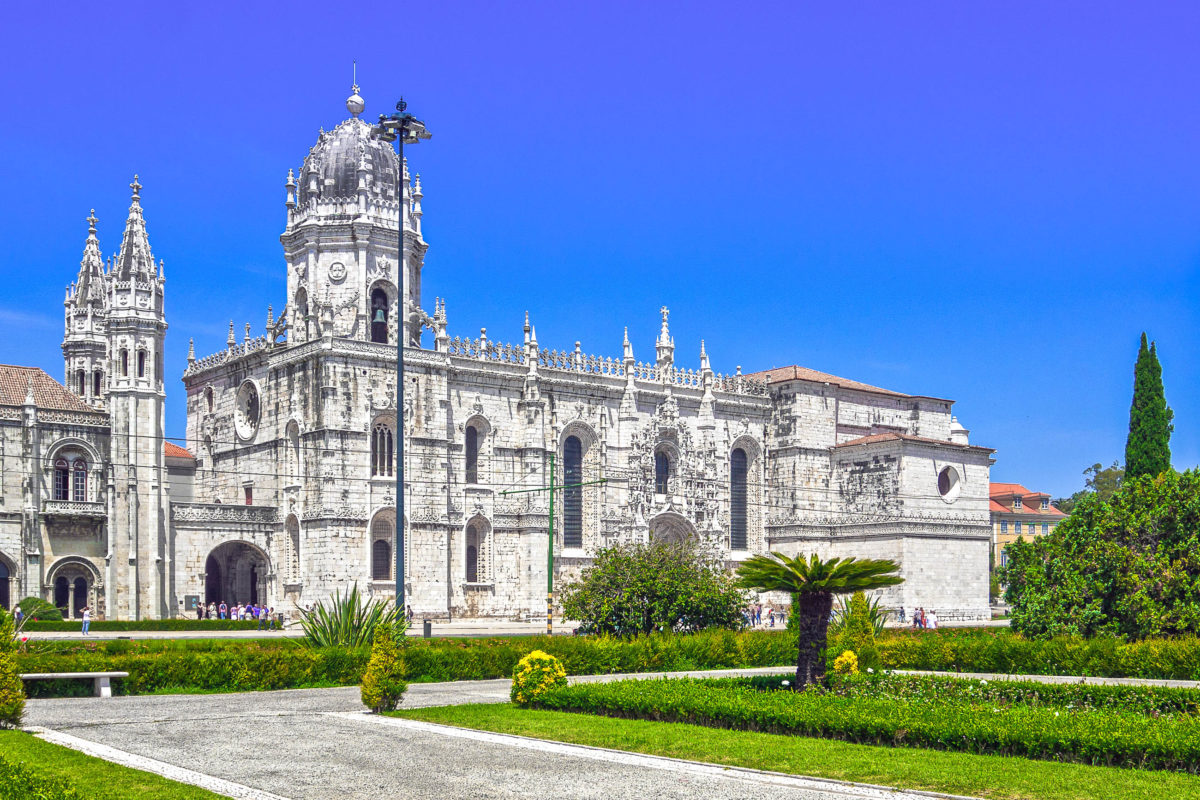
Ganz in der Nähe des Torre de Belém, ebenfalls im gleichnamigen Stadtteil, liegt das prächtige Mosteiro dos Jerónimos aus der Blütezeit Portugals im 16. Jahrhundert. Damals kam Vasco da Gama gerade aus Indien zurück und der Gewürzhandel über den neu entdeckten Seeweg brachte immensen Reichtum mit sich. Vasco da Gama ist im Übrigen eine der berühmten Persönlichkeiten, die neben den portugiesischen Königen innerhalb der mächtigen Klostermauern ihre letzte Ruhestätte fanden.
Mit seiner überwältigend geschmückten Fassade zählt das Hieronymus-Kloster zu den eindrucksvollsten Bauten von Lissabon. Es gilt heute (ebenso wie der Elevador de Santa Justa als eines der wenigen Gebäude im Stil der Manuelinik) als UNESCO Welterbe. Auch der Klostergarten ist absolut sehenswert. Die 300 Meter lange Gartenanlage umrahmt den Prachtbau mit viel Grün und wunderschönen Blumenarrangements.
Auch zwei Museen sind hier zu finden. Das Marinemuseum und das Archäologische Museum befinden sich in zwei Seitenflügeln des ebenso prunkvoll geschmückten Innenraums.
Artikel: Mosteiro dos Jerónimos in Lissabon
Praça do Comércio
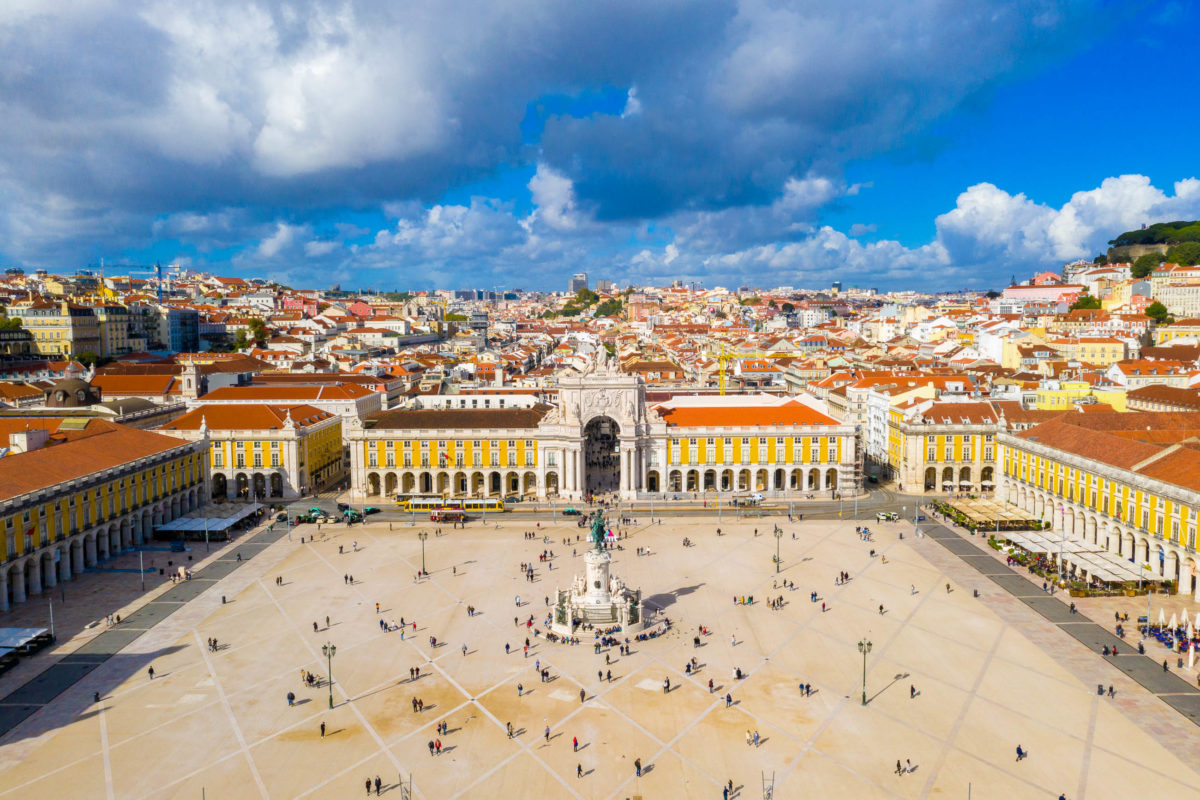
Der Praça do Comércio zählt zu den prächtigsten Plätzen von Lissabon. Früher wimmelte es hier von Händlern aus aller Welt, die exotische Waren anboten, oder Seefahrern, die nach Mitteln und Wegen suchten, ihre nächste Entdecker-Reise zu finanzieren.
Heute geht es am Praça do Comércio immer noch turbulent zu, die Händler und Entdecker wurden allerdings durch Touristen und Kulturfreunde ersetzt. Die sonnengelben Arkaden-Bauten beherbergen Boutiquen, Hotels und Restaurants, dazwischen thront der imposante Triumphbogen Arco da Rua Augusta, das Tor zu Lissabons Innenstadt. Von seiner Aussichtsplattform lässt sich der Trubel wunderbar aus der Vogelperspektive beobachten.
Rossio Platz
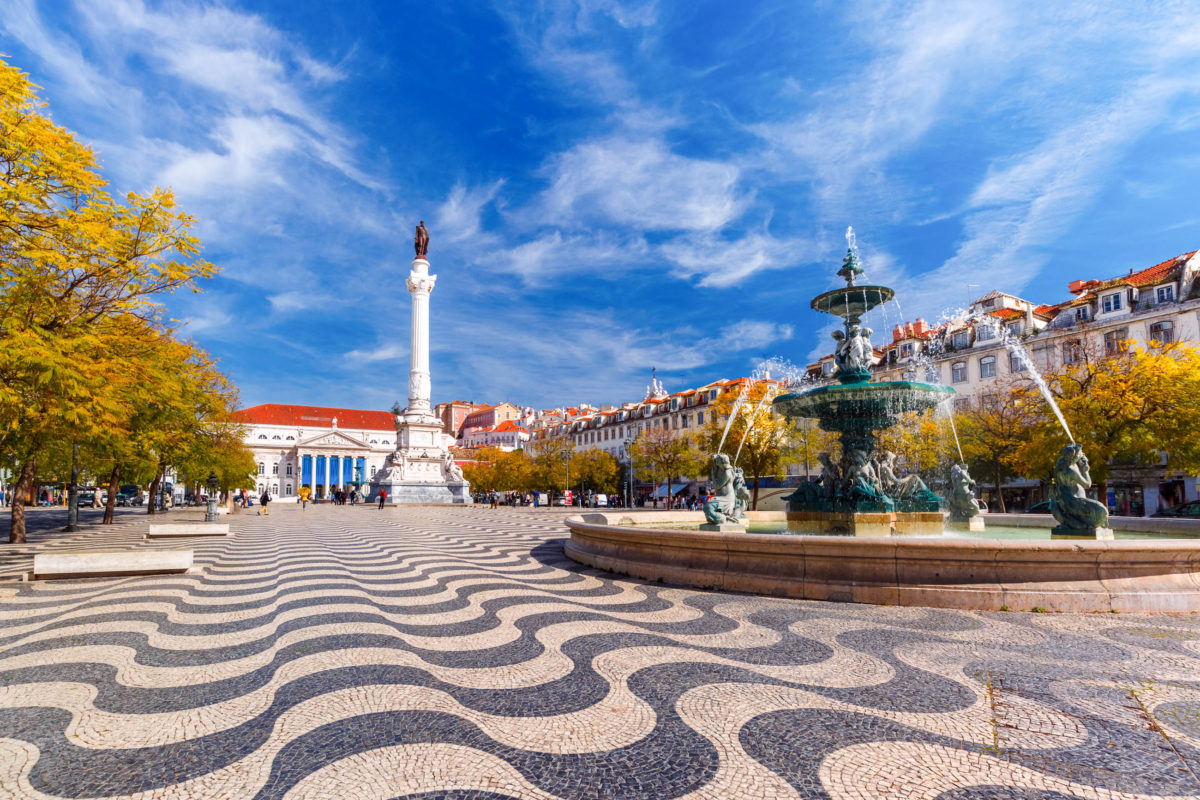
Der Rossio Platz heißt eigentlich Praça de Dom Pedro IV und zählt zu den bedeutendsten Verkehrsknotenpunkten in Lissabons Zentrum. Hier kreuzen sich einige U-Bahn- und Straßenbahnlinien, die Touristen und Einheimische in alle Teile der Stadt befördern. Auch der Bahnhof Terminal do Rossio befindet sich hier. Ähnlich der Praça do Comércio ist auch der Rossio Platz ein früheres Handelszentrum von Lissabon.
Mitten auf dem Platz thront eine hoch aufragende Bronzestatue von Pedro IV. und ein herrlicher Brunnen verbreitet angenehme Kühle. Der Rossio Platz gilt seit dem Mittelalter als Herz der Stadt, denn hier fanden seit jeher Festivitäten, Revolutionen, Hinrichtungen und sogar Stierkämpfe statt. Das wellenförmige Muster, das sich am Pflasterboden des Rossio-Platzes ausbreitet steht symbolisch für die Nähe und Bedeutung des Meeres für Lissabon.
Oceanarium
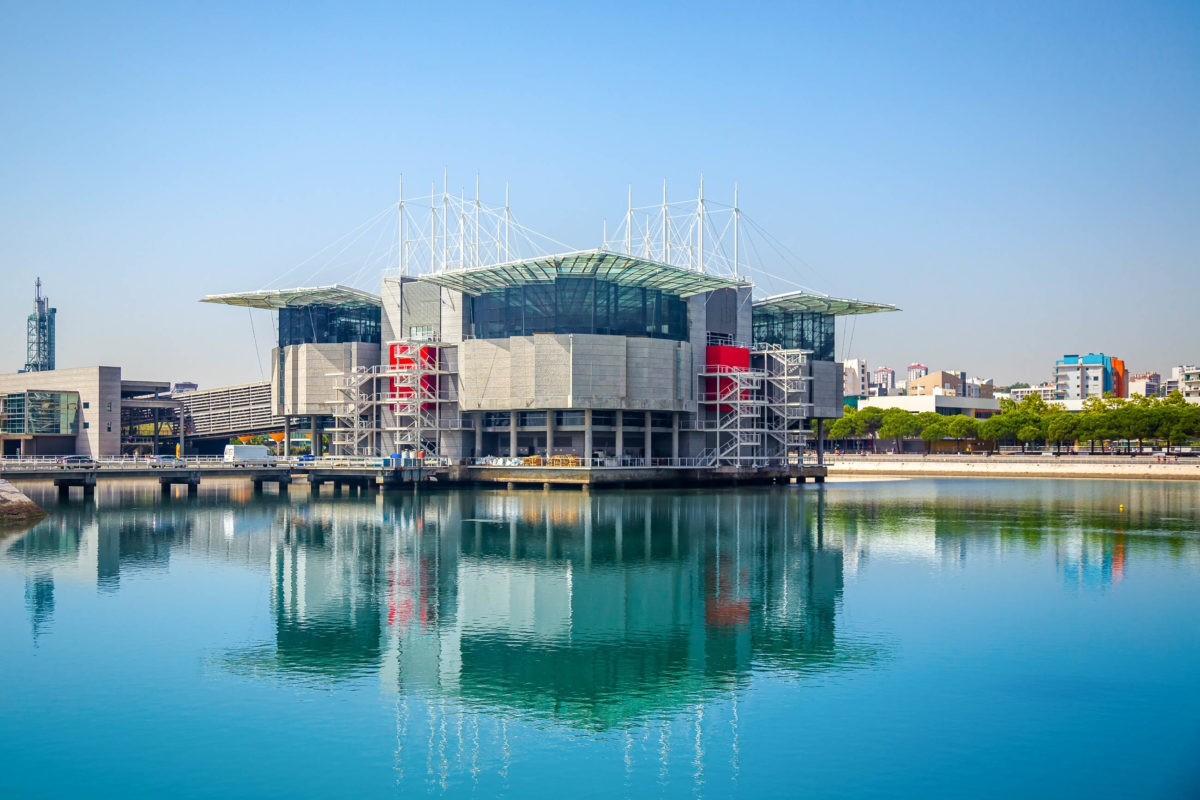
Ebenfalls ums Meer geht es bei der nächsten Top Sehenswürdigkeit. Das Oceanarium von Lissabon liegt im modernen Bezirk Parque das Nações und zählt zu den eindrucksvollsten Aquarien Europas.
Jedes Weltmeer hat in Lissabons Oceanário ein eigenes Becken, deren Bewohner von oben und unten beobachtet werden können. Im Hauptbecken leben nicht nur schillernde Schwarmfische, sondern auch riesige Meeresbewohner, wie Haie und Rochen. Über Wasser tummeln sich Pinguine und Seeotter.
Mercado da Ribeira / Time out Market

Im Mercado da Ribeira dreht sich alles ums Essen. Über 30 Restaurants befinden sich hier unter einem Dach. Das Besondere: Große Ketten und billige Imbissbuden fehlen, stattdessen wird auf kleine Anbieter mit kreativer Küche gesetzt. Die portugiesischen Spezialitäten werden hier noch um Sushi, chinesische Nudeln, Schinken, Hamburger, Eis, Puddingtörtchen und Schokolade-Leckereien ergänzt.
Bereits im Mittelalter wurde der Mercado de Ribeira urkundlich erwähnt, seit 1892 trafen sich hier die Einheimischen, um Fisch, frisches Obst und Gemüse zu kaufen.
In den letzten Jahren entwickelte sich die Markthalle immer mehr zum hippen Food-Court, wo viele kleine Portionen zum Probieren angeboten werden. Mit der Zeit etablierte sich der Name „Time Out Market“. Weil man beim Schlemmen, Shoppen und Gustieren hier wirklich die Zeit vergessen kann.
Christo Rei Statue + Ponte 25 de Abril
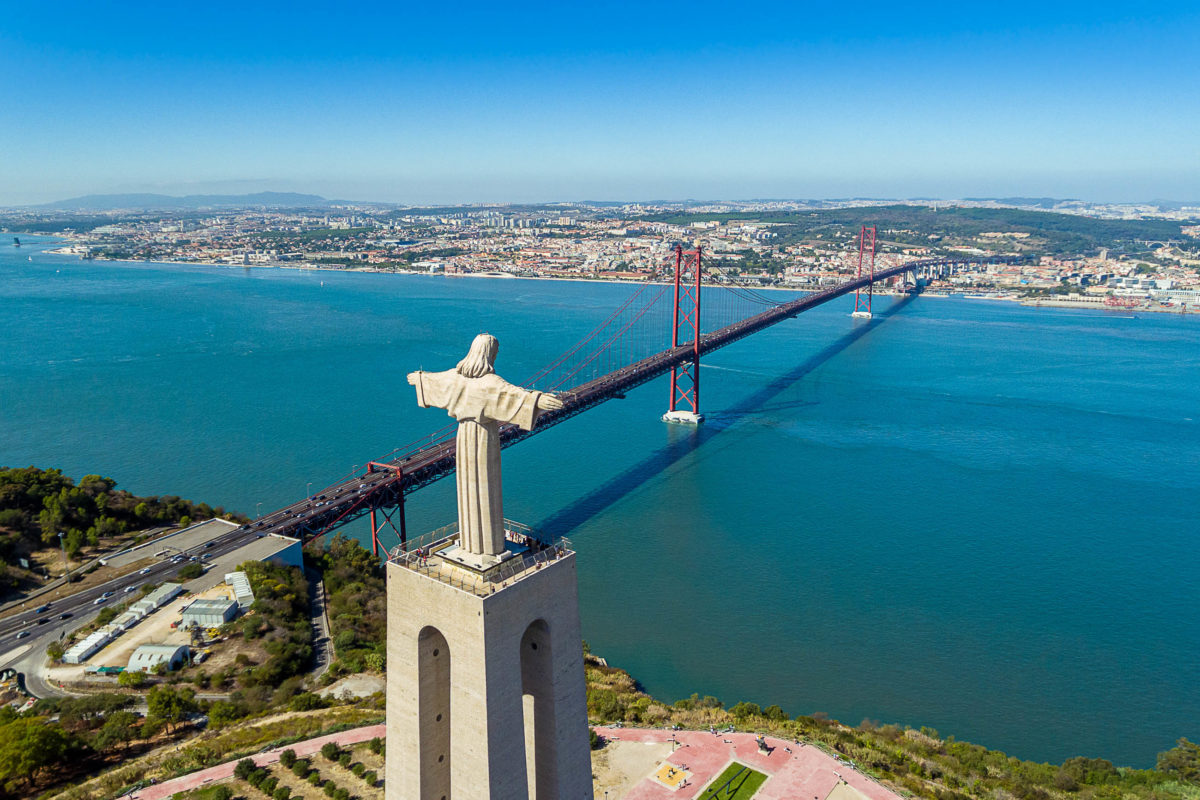
Die meisten kennen die Christusstatue aus Rio de Janeiro, doch auch Lissabon (oder eigentlich die benachbarte Stadt Almada) kann mit einem eindrucksvollen Exemplar aufwarten. Die portugiesische Christo Rei Statue überragt nach brasilianischem Vorbild das südliche Ufer der Tejo-Mündung und bietet auf 82 Metern Höhe einen sensationellen Blick über die Stadt. Mit seinem 75 Meter hohen Sockel ist der Christo Rei insgesamt 113 Meter hoch.
Direkt unterhalb der Christusstatue liegt die 2278 Meter lange Ponte 25 de Abril, die seit 1966 an der schmalsten Stelle der Mündung über den Tejo führt. Ihr Name erinnert an die Nelkenrevolution im Jahr 1974, als sich die Portugiesen gegen die Diktatur des von Salazar begründeten Estado Novo auflehnten. Zuvor hieß die drittlängste Hängebrücke der Welt übrigens Salazar-Brücke.
Auch die Ponte 25 de Abril hat einen berühmten Zwilling: die Golden Gate Bridge in San Francisco. Kein Wunder, denn beide Hängebrücken wurden damals vom selben Unternehmen erbaut. Bewundert werden kann die Brücke am besten aus der Ferne, denn ihre Überquerung ist Autos und der Eisenbahn vorbehalten.




